Best Web Analytics 2.0 Tools: Quantitative, Qualitative, Life Saving!
What is the first thing you want when you think about web analytics?
Tools!
Of course tools. What to do, where to start, what's cool.
I was reflecting on that recently and thought it was incredible that in all my years of writing this blog I have never written a blog post, not one single one (!!), recommending tools for the complete web analytics 2.0 spectrum.
Well that ends today.
My goal is to give you a list of tools that I use in my everyday life as a practitioner (you'll see many of them implemented on this blog). You are not going to use all of them all at the same time (or with every client), but 1. it is good to know what is out there and 2. to be awesome you are likely to use one from each category.
[Disclosure:] I am the co-Founder of Market Motive Inc and the Analytics Evangelist for Google. I do not have financial or equity or any other stake in any company mentioned in this blog post (except Google). None of these tools vendors have any relationship with Market Motive either. They are on this list because IMHO they provide value and are better than their competition. [/Disclosure]
Before we jump into tools a few key bits of context, after all context is queen!
First Bit Of Context. . . Web Analytics 2.0.
This blog post is about web analytics 2.0. Not just clickstream analysis.
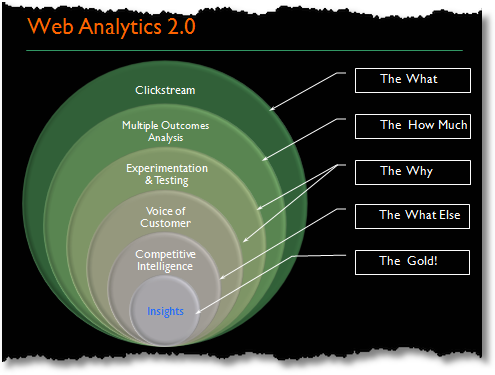
As defined in my second book Web Analytics 2.0 is:
1. the analysis of qualitative and quantitative data from your website and the competition,
2. to drive a continual improvement of the online experience of your customers and prospects,
3. which translates into your desired outcomes (online and offline)
An expansive view of what it means to use data online, both from the type of data perspective and the kind of desired impact perspective.
Second Bit Of Context. . . Multiplicity.
Given the definition above, I am a firm believer in Multiplicity.
Every single company, regardless of size, will require multiple tools to understand the performance of its website, happiness of its customers and glean key context from competitors and ecosystem evolution.

The quest for a "single source of the truth" on the web is futile.
Actually let me rephrase that. . . the quest for a single tool/source to answer all your questions will ensure that your business will end up in a ditch, and additionally ensure that your career (from the Analyst to the web CMO) will be short-lived.
Sorry.
You should know upfront that you are going to fail, often spectacularly, if you don't embrace the fact that you have many complicated questions to answer, from many different sources.
To be an Analysis Ninja, and part of a successful web business, embrace Web Analytics 2.0 and embrace Multiplicity. Use a clickstream source when you have to, switch to testing to move beyond HiPPO's and inferences from click data, invite customers on a regular basis share feedback with you using surveys and usability, and poke and prod your competitor's and ecosystem performance to know what to do more of and what to do less of and what you have been blind to.
Do that. Work hard. Win big. Rinse, repeat.
Third Bit Of Context. . . Don't Be Scared: Prioritize.
Many people get really scared and run for the hills when they first put Web Analytics 2.0 and Multiplicity together.
Don't be.
Depending on the size of your company (translation: resources available and what's impactful and doable) here is the priority order that I recommend for you to execute your web analytics tools strategy right. . .

Not everybody should do everything in the same order. In my humble experience the above order works best for small, medium and large sized companies.
The result of going in a specific order is that this does not have to all be done overnight. You can take your time and evolve over time.
For more on why I recommend this specific order please see my second book, Web Analytics 2.0, which many of you already have.
Fourth Bit Of Context. . . The 10/90 Rule!
I can't ever talk about tools without reminding you of my 10/90 rule for magnificent success in web analytics.
First presented at an eMetrics summit in 2005 the 10/90 rule was borne out of my observations of why most companies fail miserably at web analytics.
Put simply it states:
If your have a budget of $100 to make smart decisions about your websites… invest $10 in tools and vendor implementation and spend $90 on Analysts with big brains.
Summary: Its the people.

You may not go with precisely 90, that is ok. But overinvest in people and everything that is required to make those people successful: invest in process, invest in their training, invest in large monitors for them, invest in backing them up against senior management, invest in involving them in key business strategy meetings, invest in… you catch my drift).
The coolest tools, the really expensive tools, will deliver diddly squat for your business. They'll simply puke data faster and, if you implement them right, more efficiently.
It's your investment in the 90 that will deliver glory.
People matter.
With those minor caveats, and what it takes to be successful refreshers, I am really excited to tell you all about tools!
: )
The Best Web Analytics 2.0 Tools For Maximum Awesomeness!
Let us break this list into the components of Web Analytics 2.0 so you have some reference as to where each item fits (and this will also make it easier for you to pick tools for the priority order referenced in Context #3 above).
Clickstream Analysis Tools [The "What"]
To many people the clickstream world is all there is to the web analytics world. It is without a doubt the largest source of data you'll access.
There are hundreds (I kid you not) of clickstream tools, I recommend you keep your life on the straight and narrow and pick one, just one (!), of these three tools:
~ Yahoo! Web Analytics
~ Google Analytics
~ Piwik
Yahoo! and Google provide world class web analytics tools for free.
Custom reporting, advanced segmentation, advanced rich media tracking, auto-integration with search engine PPC campaigns, advanced mathematical intelligence, algorithmic data sorting options, complete ecommerce tracking, super scalable sophisticated data capture methods such as custom variables, open free and full API access to the data, loads and loads and loads of developer applications to do cool data visualizations, data transformations, external data integrations and more. I am forgetting the other 25 features these tools provide for free.
Additionally if you look at the massive progress these two tools have made in the last 24 months there is hardly anything, more like _nothing_, they can't do that other vendors, free or paid, can do.
There would have to be an overwhelming preponderance of evidence showing that your company is magnificently unique, extremely special and with such incredibly uncommon needs that you need to go with any other clickstream tool (including paid clickstream tools from Omniture, CoreMetrics, Unica, WebTrends or anyone else).
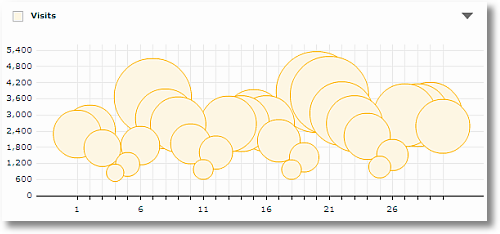
If you have never done web analysis, start with one of these two.
If you have always done analysis and only use clickstream tools like Site Catalyst or Coremetrics Analytics or WebTrends Analytics then switch to one of these two tools and invest the money in Analysts (and wait just a couple months for your mind to be blown by valuable insights).
This is not to say paid web analytics tools (that do more than just clickstream analysis) don't provide value.
If after rigorous analysis you have determined that you have evolved to a stage that you need a data warehouse then you are out of luck with Yahoo! and Google, get a paid solution. If you can show ROI on a DW it would be a good use of your money to go with Omniture Discover, WebTrends Data Mart, Coremetrics Explore.
If you have evolved to a stage that you need behavior targeting then get Omniture Test and Target or Sitespect. Good use of your money.
Etc etc.
Spending money on the base solutions from paid vendors is a very poor use of your money.
IMPORTANT: Many people think it is hard to get the free Yahoo! Web Analytics. Not true. There are three specific ways to get Yahoo! Web Analytics. Read this: How do I get a Yahoo! Web Analytics account?
If you are technically oriented, don't trust either Yahoo! or Google and up for an adventure I highly recommend you consider using Piwik.
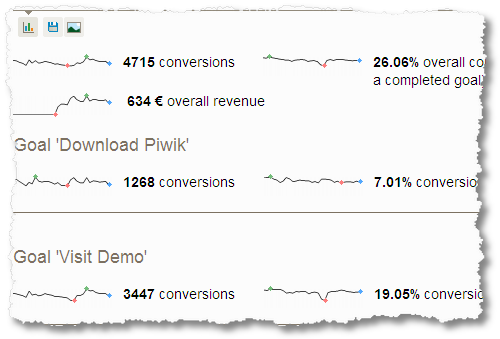
It is a wonderful solution. It has been constantly updated in the two years I have watched it. Piwik provides you plenty of capability to explore your inner technical unicorn while allowing you to answer business questions.
Three tools. Pick one. Move on with your analytical lives. Move from a data collection obsession and develop a crush on data analysys.
Special Recommendations:
Any website that provides an RSS feed would do very well to use Feedburner.
There is a lot of clickstream activity that is happening inside your RSS feed (and away from your website). Without Feedburner you have zero insights into that behavior of your most precious customers, those who are pulling your site/blog/marketing without you having to hound them.
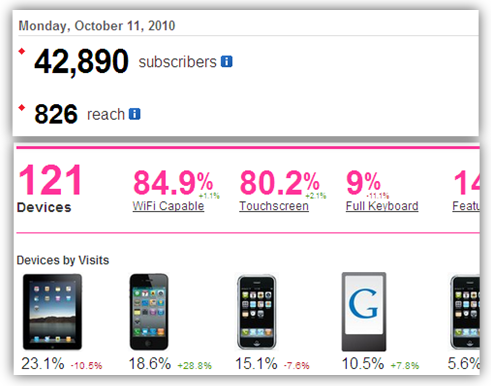
Most web analytics tools (including all the ones mentioned above) provide not great data about consumption of your website on mobile devices. By default they only work with JavaScript tags (Percent Mobile will also capture behavior on non JavaScript enabled phones) and even then their databases of phone attributes and carrier attributes are quite poor.
So if you want really good mobile behavior data (in a separate but useful silo) then go get Percent Mobile. There is a free starter edition if you just want to play with it.
~ Google Webmaster Tools / Bing Webmaster Tools
Most web analysts are not responsible for SEO Analytics, and it is such a shame. A huge vast majority of clicks coming from search engines continue to be organic clicks (which is why I love and adore search engine optimization).
Any web analytics on your site will tell you how many clicks came to you from a search engine. But do you know your organic impression share for your top keywords? You can only get that from Webmaster tools (I know, I know, it would look really good in Google Analytics!).

Besides that to me SEO is an important part of marketing. I consider it my business as a web analyst, to report on how well the site is being indexed, keywords it is showing up for (but not getting clicks for), changes in trends for impression share and clicks on search engines (via the brand spanking new Google Webmaster Tools report) etc. I consider that to be web analytics.
You may not. But I believe you'll do your company a great service if you do, and now you know where to go to get started. :)
Outcomes Analysis Tools [The "How Much"]
Most outcomes analysis you will do in identifying your macro and micro conversions (for profit or non profit sites, government or ecommerce) will happen inside other tools mentioned in this blog post.
For example you'll configure goals and ecommerce tracking in Yahoo! Web Analytics or Google Analytics or Piwik. You'll measure Task Completion Rate in 4Q (below). You'll measure Share of Search using Insights for Search (below).
Or, if you truly want my admiration, you'll compute Profit and Margin for your campaigns in Microsoft Excel or using the most relevant database query.
So no specific tools recommendation here. Only a plea to obsessively obsess about measuring outcomes and compute economic value, not just revenue. [See Quantifying Economic Value on page 159 of Web Analytics 2.0.]
Special Recommendations:
I'll make two types of multi-channel analytics outcomes recommendations here.
If you have a phone number on your site then you would be very well-advised to implement a phone call tracking solution on your website.
~ Mongoose Metrics
~ ifbyphone
I know Mongoose Metrics a bit more and have been impressed with their solution and evolution over the last couple of years. My trusted friends have been equally impressed with ifbyphone.
It is pretty easy to integrate phone outcomes data with your web analytics solution. See this video by ifbyphone: Google Analytics Phone Call Integration or this page on the MongooseMetrics site: AccuTrack. These solutions also integrate with other web analytics tools.
![]()
If you spend any decent amount of money on email, search or display campaigns and have a phone call option then it is pretty criminal not to use one of these guys to get a really good understanding of offline conversions. Without them you might be missing such an important part of the "what have we actually accomplished on our website" equation.
If you offer a live chat option on your website then outcomes can also be measured in a lovely manner using the LivePerson solution. With simple configuration updates in the tools you'll create a custom report showing you Source/Campaign, Visits –> Live Chat % –> Goal Conversion Rate –> Per Visit Goal Value.
![]()
Sweetness.
Experimentation and Testing Tools [The "Why" – Part 1]
I firmly believe that God created the internet so we could fail faster. I know of no other way to achieve one's global maxima on the web.
The fact that this is a great way to prove HiPPOs right or wrong is a bonus. The fact that this is perhaps the most amazing way to get your customers involved in creating win-win offers/content/experiences/outcomes is the cherry on top of the bonus.
GWO is free (you don't have to use AdWords or Google Analytics to use it) and is perhaps all you need as a robust A/B and Multivariate (MVT) testing solution.
Here's a free guide – 26 pages – to use the website optimizer optimally: PDF Download: The Techie Guide to Google Website Optimizer.
If you need ideas of what to test: Experiment or Die. Five Reasons And Awesome Testing Ideas.
No serious web analytics program in any company is complete without robust and persistent testing. None. Not a single one.
Special Recommendation:
If you want to jump into testing very very fast and start doing A/B testing tonight (I am not kidding: tonight!) then I recommend using Optimizely.
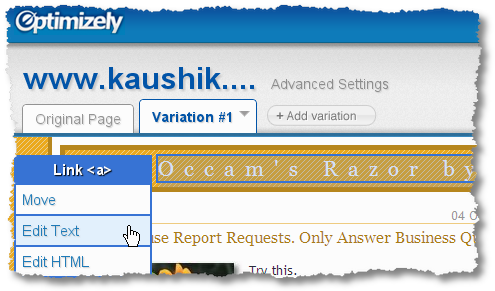
Slight amount of technical knowledge will be a plus, but it is really really easy to get started. Just go to their site and type in your URL in the blue box and hit the green button and you'll see what I am talking about. You'll be setting up you A/B test in 5 mins.
They even have a Platinum support plan where you get the CEO's direct cell phone number! How can you not totally love that? : )
~ AdWords Campaign Experiments by Google
I wish I could put into words how much I love ACE (AdWords Campaign Experiments). It is truly a blessing for anyone that does paid search marketing.
So many companies large and small truly suck at doing AdWords properly. And it does not matter if they use a large brand name Agency. This sucking can be solved immediately and awesomely by using ACE.
Adgroups and match types and content and copy and URLs and keywords and negatives and positives and bid prices and so many levers to pull to improve Impressions, CTRs and ROI of your AdWords campaigns.
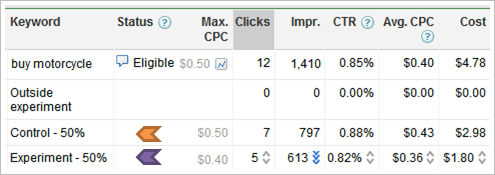
Now you don't have to do the super lame before and after “experiments”, you can do true test and control experiments and learn how to win, and win big, at this AdWords thing you are spending so much (or so little) money on.
I hate to be a bearer of bad news but if your company or Agency is not using ACE every day to make you a ton more money, then fire someone.
Here's all you need to know about ACE: AdWords Campaign Experiments Videos & Guides.
Voice of Customer Tools [The "Why" – Part 2]
It is quite incorrect to believe that by analyzing the clicks of visitors to your website that you suddently have an ability to capture "voice of customer". That would be like trying to talk to your mom while holding a banana to your ear instead of a telephone.
I have been profoundly humbled by how much one can learn by using qualitative methods to collect VOC.
Of the hundreds of online survey providers out there, here are two of my current favorites:
~ 4Q by iPerceptions
~ KissInsights
I am extremely biased towards sensible short surveys, versus many people's preferred option of a 42 question puke "survey". I have come to realize that asking just a few right questions translates into a respect for the website visitor's time, an extreme focus at your end, and, blessedly, action by your company based on VOC.
4Q is a "site level survey." By default you ask just four questions (though you can add two more optional questions) when people exit your site. It provides the Key Performance Indicator that I consider to be the holiest of the holy in web analytics: Task Completion Rate (segmented by Primary Purpose).
If you want to see how 4Q looks and works click here.
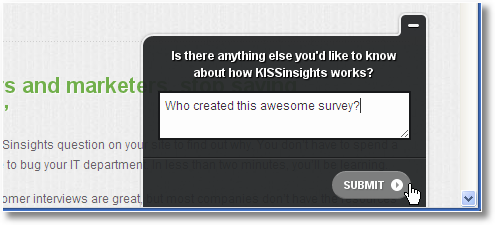
KissInsights is a "page level survey." You ask one question (how can you not love that!) and have an ability to get a yes, no or open text answer. The survey invite is unobtrusive. You can control the amount of time spent on a page before the survey shows up, you can add conditional logic, and so much more, to the survey invitation process.
If you want to see how Kissinsights works just go to site and customize your own in a few seconds.
Both 4Q and KissInsights come with free starter solutions. Both are available in multiple languages. Each solves a different problem, and solves it very well.
Another great way to collect voice of customer (VOC) is to do usability studies. A recent sweet development is that you don't just have to rely on often expensive lab usability studies. You can conduct affordable, scalable and frequent online usability studies.
~ UserTesting.com
~ Loop11.com
For $39 a pop UserTesting.com allows you to specify the demographic and other attributes of the users you are most interested in and then have those users complete tasks you specify on your site. You get a video and a written summary of their experiences. Nothing more powerful than actual frustrated users right?
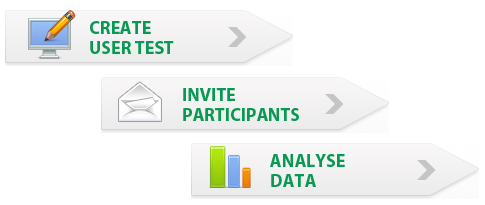
Loop11 is different in several small ways but the primary difference is that you pay a flat fee of $350 for each study while allows you to have to 1,000 participants and unlimited number of tasks. You are also in control of study participants and you can invite them via social media or a pop up on your site.
They also have a sweet demo, check it out here: Loop11 Participant Demo. The demo is a sweet way to convince your boss to give you money for a usability study (with either company! :)).
Finally one last VOC recommendation, this one very tactical and focused on single page optimization (vs. site and experience optimization with the voc tools outlined above).
On the surface it looks like a site for designers, but the reality is that this is a site for every Marketer, Analyst and pompous or humble HiPPO in the world.
You upload one of your pages and you have three options to collect feedback. You can get public feedback from their community of professionals (currently 8,000). You can get feedback, privately, from your company folks or current customers. Or finally (this is really cool especially if you are a small/medium sized company) you can get feedback from a Design, Usability and Marketing expert for a total of $300. How awesome!
If you want to see a sample of how this works check out this example, or many others on their site.
Now go look at your Top Landing Pages report, check out the pages with the highest bounce rates, upload them into Concept Feedback and stop stinking!
Special Recommendation:
Bounce has fewer features but I have to tell you I absolutely love how simple it is to set up and how lovely the UI is. Same thing as above: type the URL of a page on your site into Bounce, share the URL with others, get feedback.
Check out how it works on this page I have just created in Bounce for Market Motive.
Competitive Intelligence Tools [The "What Else"]
Two simple and powerful reasons for embracing, nay jumping into bed all naked, with competitive intelligence data:
1. Get context to your own performance vis-a-vis your competitors (the ones you know about and the ones you don't)
2. Analyze ecosystem trends, opportunities, failures, impact of your tv ads, emerging customer preferences and changes, and. . .
I could keep going on.
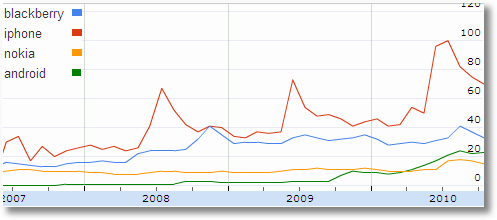
Here are tools I use on a daily basis:
~ Compete
~ Trends for Websites
~ Insights for Search
~ AdWords Keyword Tool
~ DoubleClick Ad Planner
[Before you use any of these tools please please please read this blog post: The Definitive Guide To (8) Competitive Intelligence Data Sources]
Compete is a great place to get quick data about US Visitors for any website. Compete uses a mix of data collection methods (read post above) which makes their data much better than many others. Notice at the bottom of the report that you also get top five referral and destination sites as well as search analytics. If you pay you get a lot more. If you think a website gets more than 50k unique visitors a month chances are their data is well reflected in Compete (for US visitors only).
Trends for Websites is the place I got to for worldwide visitor data for websites located in any part of the world. It uses one of the largest sources of data in the world and can be an excellent way to understand Traffic, Search Keywords, and Also Visited data for a Chinese site or one from Brazil or South Africa.
[Learn more about the types of analysis you can do: Competitive Intelligence Analysis: Google Trends for Websites]
Insights for Search is one of my secret crushes. I love the fact a common person like me can have access to the world's “database of intentions” for free. It's like having a hose directly plugged into humanity's brain and understand what it (or segment of it) is thinking, feeling, doing. I use Insights for Search to analyze industries, analyze share of search, emerging trends and, this might seem odd, where to do offline advertising based on consumer intent.
[Learn more about the types of analysis you can do: Competitive Intelligence Analysis: Google Insights for Search]
AdWords Keyword Tool is impressive not just because of the petabytes of data it mashes together with ease but also because it is a source that 1. helps me refine my search engine optimization (SEO) strategy 2. download all the specific user-typed long tail queries for optimal PPC targeting and 3. get insights into specific verticals or brands I care about or am currently analyzing.
[Learn more about the types of analysis you can do: Google's Search Based Keyword Tool: Monetize The Long Tail of Search]
DoubleClick Ad Planner is my go-to source for demographic and psychographic analysis for any website or, how amazing is this, the whole entire darn internet! And this is the most amazing part, you are about to have a minor orgasm, it is the only source in the world where you can marry user attributes (content consumed, demographic, psychographic etc) with their Search behavior! It is impressive to get that type of insight into users. It is silly to ever do a single display advertising campaign (via any company: Atlas, Yahoo!, DoubleClick, AOL, etc) without using the data in Ad Planner.
[Learn more about the types of analysis you can do: Competitive Intelligence Analysis: Google / DoubleClick Ad Planner]
Regardless of the size of your company and regardless of your title, a "lowly" Analyst or Senior Squirrel or Director of Analytics & Optimization, if you don't do competitive intelligence analysis you don't do analytics.
Miscellaneous Emerging Analytics Tools [The "What Else Could I Possibly Do"]
Yes you are right that in my Web Analytics 2.0 framework there is no category called "what else could I possibly do." I am glad you are paying attention. : )
Unfortunately for you and me daily evolution is the norm on the web. We are faced with new marketing and measurement challenges and opportunities every single day. Here are some tools that I use to measure the emerging bleeding edge of those challenging opportunities. . . .
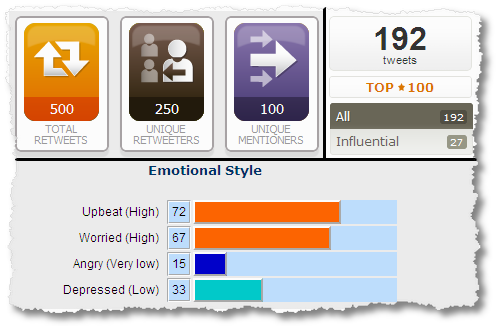
Twitter to me is a proxy of how data collection is changing and what the future of relevant metrics might look like. I explore that using these tools:
~ Klout
Klout has some of the cleanest metrics when it comes to measuring performance of a single twitter account. They've just added Facebook integration and measurement, a step in the direction of measuring our entire social presence.
~ Topsy
Topsy is a really good social search engine but I have found that it is the cleanest and most comprehensive when it comes to tracking the tweets and retweets of my blog posts (or pages on your site that can be tweeted/retweeted). Number of tweets about the page is now a key part of my Conversation Rate metric for any page on the site.
AnalyzeWords to me is what sentiment analysis should be like / might be like one day. Rather than a quest for a non-useful shortcut like "positive" – "negative" – "neutral", it offers a real nuanced psychological analysis of data. [Learn more: Sentiment Analysis]
Another tool that takes a similar, but different, approach is TweetPsych.
Finally a small peek into how lots and lots of data that is fragmented today, spread between your site analytics tools and lots of other sources out there, is going to come together and delight you. . .
A huge number of consumption of your content happens offsite (and hence is invisible to Omniture or WebTrends or IBM or Google Analytics). An even huger and scarier amount of influencing of your potential and current customers happens outside channels and locations where you exist. PostRank starts to bring all that together.
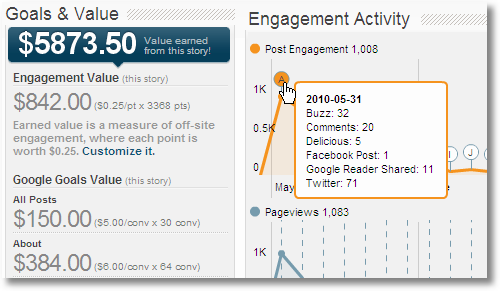
All your current website data (at least Google Analytics) and all your consumption and influence data from the social web. All in one place having a ménage à trois producing pretty babies. check them out, as you can see even from the cropped screenshot above, haivng all that data in one place transforms your understanding of success (or failure).
That's all I got for today. Phew!
Parting Words of Wisdom from a Practitioner.
I had promised tools and you got tools! Perhaps more than you cared for.
But do remember three very very important things:
1. You simply cannot survive in this world with a clickstream mental model. You have to embrace Web Analytics 2.0 and Multiplicity, or take a job in a different field because you'll be miserable in this one.
2. You don't have to use all the tools. See the priority map above. You should use at least three (again see the order in which you should implement them in the priority map) and be experimenting with one or two others.
3. If there is one thing you should be convinced of by now it is why following the 10/90 rule is so desperately and supremely important.
Every tool above is either free or has a limited free plan or is extremely affordable. Every single one is amongst the best in its class. And yet none would be useful unless you had a Michelle or a Amir or Enrique or Sasha who understands your business and has the drive to use the right tool intelligently to deliver actionable insights.
Happy Analytics!
Ok now its your turn.
Does your company have a clickstream web analytics strategy or a true Web Analytics 2.0 strategy? How many tools do you use on the website you are responsible for? Which of those are your favorites? Have a missed a truly exceptional tool in my list? Which of the above tools have you tried, and what's your experience with them? What is the tool you are dying to get, but has not yet been invented?
Please share your feedback / critique / thoughts / wisdom via comments.
Thanks.
PS: Ok ok ok. I know what you are asking for. Here's a handy dandy list of all the tools listed in this blog post:
+ Clickstream Analysis Tools [The "What"]
~ Piwik
Special Recommendations:
+ Outcomes Analysis Tools [The "How Much"]
+ Experimentation and Testing Tools [The "Why" – Part 1]
Special Recommendations:
+ Voice of Customer Tools [The "Why" – Part 2]
- ~ 4Q by iPerceptions
Special Recommendations:
+ Competitive Intelligence Tools [The "What Else"]
- ~ Compete
+ Miscellaneous Emerging Analytics Tools [The "What Else Could I Possibly Do"]
To infinity, and beyond!!











October 19th, 2010 at 03:00
To me this is the single most important read that I have seen since I began my journey to become an analytics analyst. Pure gold Avinash. Although I have ended up saying this to you all too often thank you again and again.
October 19th, 2010 at 03:18
So many tools…so many tools…so great information. I think this post illustrates the complexity of web analytics.
The field might at first look very narrow but it is actually huge. The bottom line is though to get insights just as you Avinash point out on most of your posts.
I get contacted from time to time by companies looking for web analysts and 9 times out of 10 they have a very narrow view of what a web analyst does. Usually they think it is mostly about reporting. When I trying to explain that web analytics is so much more I can see that their eyes go blank. They truly dont understand the complexity and more important the potential within the data and the field. Combining all the great tools and one can become as data savvy as Google (more or less).
Where I currently work we use many different tools to draw insight and we have moved from the reporting towards the conversion areas, so nowdays we have the title of conversion specialists which conveys the message a bit better to our internal stakeholders.
When they hear the word conversion specialist they can immediately understand the value and the goal. That I am just a web analyst doing whatever a web analyst does is another story.
I once drew a "board game" to illustrate the complexity of web analytics that I like to use when talking to people not familiar with the area. I have found out that it is a good starting point for conversation.
(You can find it on my blog, or direct link; http://www.onlineplanet.se/2010/02/are-you-an-web-analytics-ninja-the-game/)
October 19th, 2010 at 06:07
I'm really enjoying this post but there seems to be a bit of a problem with character encoding that makes it quite hard to read.
October 19th, 2010 at 06:09
Great list, Avinash. Any thoughts/experience/recommendations on session replay type tools like Clicktale, TeaLeaf, Foglight, etc?
October 19th, 2010 at 06:31
Many useful tools to try.
Especially thanks for Voice of Customer and Miscellaneous Emerging Analytic Tools. It can be interesting to measure correlations between social presence and click stream.
October 19th, 2010 at 06:31
Boy there are so many web analytics softwares to choose… it can be an headache… but I will agree that Google and Yahoo are leading the pack… if you got to choice something free..it will be them..
"TrafficColeman "Signing Off"
October 19th, 2010 at 06:41
Really great post Avinash. Stressing the 10/90 rule is really the key. I've found that most of the web analysts I know are frustrated by not being able to add even free tools to their view of the site (IT, HIPPO's, etc.). Many times upper management thinks that SiteCatalyst is enough. Would a tag management system overcome that?
Also what about a Tealeaf or Clicktale. I've used Clicktale in the past and it helped with usability greatly. Tying it to survey data could be truly useful as well.
October 19th, 2010 at 07:10
Hi Avinash,
Great resource list!
Going along with your 10/90 rule, I'd like to suggest picking the brain of your web development team (if available). I have been amazed at what custom solutions developers have been able to implement after a 15-30 minute meeting about what valuable data we'd like to collect.
We love using Mongoose Metrics and the insights we're able to gather from A/B landing page tests where phone numbers are available.
A tool we've used recently is Mouseflow which allows us to see video captures of user behavior on the site. We are able to segment the video recorded sessions due to our clever web developers usage of conditionals + cookie tracking. :)
October 19th, 2010 at 08:06
This was an extremely informative post full of important information. I have tucked it away for a re-read with fresh eyes to see if I missed anything else. I have previously only been using Google Analytics and Google Webmaster tools to analyze how well my website is peformiing. I have at least three other tools which I am going to investigate after reading your post. Thanks!
October 19th, 2010 at 08:24
Avinash, thanks for publishing such a great article, it is just what I needed as I think about our analytics strategy & budget for next year!
October 19th, 2010 at 08:57
Excellent post. The Web Analytics 2.0 mindset is well needed in lot of places and this post reenforces that mindset along with providing key toolsets. I have tried couple of these tools and will probably evaluate/use the rest.
Couple things
1. Your resolution is probably 800×600 just a thought it should be atleast 1024×768. Easier for bigger screens :-)
2. What do you recommend as a tool for multi dimesional querying from the clickstream data
3. Do you recommend any tool set in the SEO side where we can categorize/group keywords and analyze?
October 19th, 2010 at 09:25
Fantastic post, probably too in-depth! Looks like I've got to set aside some time to explore and experiment with those tools.
October 19th, 2010 at 11:11
Hi, Avinash….
thanks for bringing up all these tools at one place. I would like to call it Web Analytics Umbrella Tools Collection. I always read your blog post and learning from them.
Well..you have given in-depth knowledge about these tools that made this post too lengthy but informative.
October 19th, 2010 at 11:48
I just died and went to geek heaven. Thanks for all the great tools listed here. I love Multiplicity in that every day is a bit like a treasure hunt, finding and positioning all clues until the treasure is sitting in your lap.
I just signed up for a PostRank Analytics account and can't wait to see the data. Also, did you hear that 4Q will be rolling out a deluxe package with a more discreet invite, branded survey invites/thank you's and more? So excited.
Finally, I used Multiplicity (as well as your advice) in re-branding my blog this week. I wrote about the process of taking my audience's feedback and using it to drive my decisions. Thanks for your input there as well!
October 19th, 2010 at 12:01
What Mark Caldwell said. Great post but there is something screwy with encoding of apostrophes.
October 19th, 2010 at 12:27
Great post, but I must disagree about competitive intelligence ranking as the #5 priority at large organizations.
I might even consider it a #2 after VOC because it's often the case that the only way to motivate some of the largest HiPPOs to act is to show them that a competitor is outperforming them at X, Y, or Z.
Most execs with P&L responsibility are very risk-averse, and tend to have a need to follow the herd, so IMO analysts are often well-served by framing at least part of their case in this context, particularly to the extent that it helps the exec communicate the decision to others inside the organization. Simply saying that Competitor A is doing this, so we need to do it too is often more than enough to get the organizational machinery in gear.
October 19th, 2010 at 13:29
Hey Avinash – I usually joke around that Notepad and Excel are two of the best tools out there for those of us who wear all of the above hats AND also wear the technical implementation / work with the IT team hat.
May I suggest an all-encompassing IT / Tech category of tools? It would look like this:
- WASP
- HTTP Fox / Firebug / LiveHeaders / etc…
- Rex Swain
- Whatismyip.com :)
- Site Scan GA (Thanks EpikOne!)
- GA Goal Copy Extension for FF (Thanks LunaMetrics!)
- All of the great Chrome / FF extensions for WA out there now!
- Notepad
- Excel
- Right-click + View Source + CTRL+F :)
October 19th, 2010 at 15:31
Theodor: It is heart breaking how in 2010 our business leaders and clients are so unsophisticated about their understanding of the web and measurement. All you and I can do is keep plugging away and do the best we can with the opportunities in front of us, no matter how rare they are.
I love your "are you a web analysis ninja game", I am going to tweet the link so more people can take the quiz!
Andrew: IMHO the cost (people, process, $$$) is really high to record videos and find anything sensible in them. It is cute on the surface to think you can watch every session on your site, but honestly can you? Even if you can segment them at scale it is hard to infer the intent (except in obvious cases where people end up with 404's) and decide what the insight is.
As is above was not enough solutions like Tealeaf are immensely expensive requiring not just an upgrade in the Analyst resources but also engagement, hiring and support of IT staff, hardware and more just in order to implement the tool. There are a few companies that at the end of that process can get ROI, but there are just a few.
I encourage caution. I encourage being skeptical. I encourage using your 10/90 to fix all the other broken things before you jump into the dragon slaying quest that is video recording.
One wonderful think about Clicktale is that it is affordable, they have a free option as well. You can do all my encouraged actions very quickly and make up your own mind in your own situation before having to commit massive people, processes, time. The Clicktale team should be commended for that (and for other reports beyond video watching that they have built into Clicktale).
Raghu: My replies to your questions…
1. I am working on a new theme for the blog, hopefully that will fix the problem.
2. I am not sure how deep your requirements are but both Google Analytics and Yahoo! Web Analytics come with pretty sophisticated solutions when it comes to being able to do very advanced segmentation. If you find that limiting then you can step up to Omniture Discover or WebTrends Data Mart, or you can consider building your own Business Intelligence driven Data Warehouse solution.
3. In my SES Keynote today I shared http://www.wordle.net as an example of using tag clouds, and using the Juice Analytics Keyword Tree solution. They are two examples of what you want to do.
James: I am sorry you found the blog post to be too long.
I did not want to do one of those lame posts that just links to tools, with no context. And it was hard to get a list, make recommendations and try to brainwash you all at the same time! :)
D-: It makes my heart very happy that you are prioritizing Competitive Intelligence much higher than me. I am a unabashed fan of CI data and can't share enough about its immense value.
Unfortunately in my actual work trying to transform companies into being data driven, large companies, I have discovered that if they don't have any appreciation, or use of, their own site's clickstream data it is very hard to sell them someone else's (competitors).
So after a couple of failures (perhaps the problem is me!), I have optimized my own engagements to roll out with the priorities I have outlined in the post and found that works very well.
But each case in unique and I will not argue with you about the value of CI data.
Thanks so much for adding your voice to the conversation.
Joe: Thanks for adding the IT list. I was debating about that but in the end I wanted to business list (my bias!). But of course without the IT tools we can't make sure we are collecting the best possible data!
-Avinash.
October 19th, 2010 at 16:40
Phenominal post, thank you for some great resources. I was however a little surprised at the lack of mention of Woopra as a provider of clickstream metrics.
There are a number of valuable applications (from an analyst standpoint) for real-time analytics so Woopra is worth a good hard look.
October 19th, 2010 at 17:50
Hi Avinash,
Thanks for the comprehensive list of tools. Been using at least half of those in the list, and found some new toys. Thanks especially for PecentMobile. Time to sharpen my mobile analytics skills. And thanks for the ACE reminder. Really appreciate it.
Cheers!
Jun
October 19th, 2010 at 18:56
Scott: There are many many web analytics tools (the last time someone counted I think greater than 350). In this post my hope was to cover the tools that provide the maximum possible coverage when it comes to online measurement for a serious Marketer.
Some tools solve perhaps one specific problem, but ideally you want to use a tool (since you only have a finite amount of time) that will help you measure all the things you are doing with your campaigns and website.
With regards to real time data… Here is a blog post that you might find to be of value:
~ Is Real-Time Analytics Really Relevant?
The post outlines the sub optimal impact of using real time data and shares four conditions that need to be met before a company is able to leverage real time data.
Most of the time we feel good having access to real time data but it is important to check if the required conditions are met to ensure it does not become a distraction.
Thanks,
Avinash.
October 19th, 2010 at 20:39
Avinash,
This is an excellent resource for anybody.
As is pretty evident from your write-up, there is no dearth of tools or the data that can be gathered and spout out. And as you stress repeatedly, without good analysts who can work their magic on the information collected, the wealth of insights will remain buried for most part and the money spend on tools will be for naught.
Your post resonated with me as I have always felt that the context should drive tool acquisition and usage. By context I mean – the firm's web maturity, analytical maturity (including resources), # of channels in play, culture, and market position. This coupled with the goals should provide a good idea on where one should start and if they even need to spend millions to get to where they need to be in the near-term.
Once again – a great post and reference.
Regards,
Ned
October 19th, 2010 at 22:50
Excellent round-up of analytics tools, including how/why/when to use them, along with links to more in depth information on specific analysis practices.
October 19th, 2010 at 23:13
If you are small (not serious Marketer at least not yet) and curious (want to know what you do and why) – you might be interesting in reading about our approach to web analytics – http://www.deepshiftlabs.com/dev_blog/?p=401&lang=en-us
We are not building a web analytics product #351 we just want to know ourselves :)
October 20th, 2010 at 04:26
What an amazing post!
I've only been following your work and bought your books a few months ago, but your enthusiasm, knowledge and overall passion is incredible.
I've definitely caught Avinash-itis.
You've helped me, my business and all my clients hugely. I can't thank you enough.
October 20th, 2010 at 06:41
Avinash –
Thanks for the response. Read the other post, "Is Real-Time Analytics Really Relevant?" To which the answer (based on your analysis) seems to be "Yes" depending on the circumstances and your ability to deal with it.
I would whole-heartedly agree that real-time isn't relevant or necessary for everyone, and for those it is relevant for, its in't necessarily needed 24/7 but I think it's a disservice to suggest that it isn't beneficial. I work with large companies (fortune 10) and very small (one mans shops) and have seen a number of instances where real time analytics can get put to good use, sometimes it's one off scenarios, other times with day-to-day operations. I guess my point is "Why not have it?" Cost might be one factor, but that depends largely on your needs.
I woud also agree that the key to getting something out of real-time is to have process inplace to deal with the information as it comes in. Ad Words campaigns see the most obvious models. Just staring at the data is useless (but fun). However having a plan of attack, perhaps something of a decision tree, will make an individuals or organizations ability to make adjustments on-the-fly a bit more practical.
As our general use of analytics improves we'll find more and more ways (needs) for real-time. I'd compare it to the stock market and how trading has changed (for better or worse) with the advent of real time market information. RT doesn't matter to everyone that owns stock but it's the lifeblood of a lot of swing an day traders, who, if they are successful at all, execute against that information with a plan (e.g. a stop loss) already in place.
Just thoughts but depending on one's business model, RT is worth considering.
October 20th, 2010 at 08:42
Oh, god…this post is amazing! Here is the "Web Analytics Power Suite"…the better tools, process and reports tips…
Thanks for sharing, Avinash! ;)
October 21st, 2010 at 01:32
in regards to this comment:
"Or, if you truly want my admiration, you'll compute Profit and Margin for your campaigns in Microsoft Excel or using the most relevant database query."
an alternative: you can send the profit/margin into Omniture Sitecatalyst.. this is something very valuable and useful for companies!!!! since, you can actually measure how each marketing channel is profitable
October 22nd, 2010 at 01:33
Avinash,
I have a question that is not related to this post but would love to know.
Which WordPress plugin do you use on your blog so that your mobile users can read your blog posts easily?
I'm looking for one for my blog and would greatly appreciate any direction.
October 22nd, 2010 at 23:39
Scott: On this we completely agree: Evaluate your needs against the four mandatory pre-requirements and if the foundational elements exit then go grab real time data.
To your other point I am afraid I'll humbly disagree. There is a severe downside to "why not have it". The post on real time outlined eight. This is especially corrosive if you go out and grab a siloed tool like Woopra.
We have a hard enough time doing what's important with data we already have. I am biased against grabbing ever more data that has no clear use or no clear connection to actionability. Especially for Fortune 10 companies.
The nice thing about real time data is you don't have to horde it. When your company is ready, the four foundational requirements are met, you can turn real time on. It is not like not having real time data when you don't need it will cause much harm. :)
Robert: You are absolutely right. That is a great functionality in Site Catalyst and currently not possible in Google Analytics or Yahoo! Web Analytics.
I find many times people are very uncomfortable with uploading margin data "into the cloud", there is even more of an issue with Google and Yahoo! tools. Hence I had mentioned the option most people end up doing, taking data out of the API and doing Margin analysis outside the WA tool (even if they use omniture, webtrends etc).
But those that do upload it into Site Catalyst are much better placed to do this analysis right there, thanks for pointing that out.
Avinash.
October 25th, 2010 at 18:53
Avinash,
Thanks so much for all the recommendations and useful tools – really great stuff. I found a lot of these in your Mixergy interview ('The "minor orgasm" of using analytics well'), and it's really helpful to see all of these different resources in one place. There are a lot of good tools in your list, and in fact we've just started using KISSinsights on our site – looking forward to getting some good results with that
On the usability front, there is another tool I'd like to suggest (disclosure, I work there): IntuitionHQ.com. We designed this tool to make usability testing much more accessible and affordable to regular people – $9 a test – and to have the features that we as designers need in our everyday workflow.
As such, you upload a screenshot and set a task, and then IntuitionHQ will generate a heatmap of where people are clicking and how long it takes them to click. Simple information to be sure, but often just what we need. We also do A/B testing, so you can compare two designs against each other in terms of usability – something we've found to be very useful. Hopefully you'll be of the same opinion.
Anyway, thanks for all these great tools – it's really very helpful to have a collection of resources like this to work with. We are slowly implementing many of your tips across out sites.
Cheers,
Jacob.
October 26th, 2010 at 04:07
Wow, what a great article, learned a lot today, thank you!
Cheers,
Tim
October 26th, 2010 at 04:37
I am glad that there are people out there who are making sure guys like me don't mess everything up.
Thanks for the tool advice!
October 26th, 2010 at 06:17
Great post Avinash.
I haven't been able to do much reading lately with increasing client responsibilities but I know I'm missing bunches when I don't get to ready your blog posts, so I circled back and am I glad I did. A wealth of tools here I can immediately bring into consideration with clients.
Thanks so much for the insight and leadership!
October 26th, 2010 at 07:47
WOW!!!
Thank you for sharing your knowledge in web analytics with us! Very cool!
Cheers,
Domicio Neto
October 26th, 2010 at 08:10
Avinash,
I appreciate your Great "Generosity", and "Selflessness".
This post should be a lifeline for every "Web Analyst".
Jawed Ahamed.
October 27th, 2010 at 02:40
One of the best posts on analytics..
October 28th, 2010 at 04:31
[...]
And all this does not have to be hard.
Every tool you could ever want to have, from clickstream to mobile analytics to testing to surveys, can be had for free or cheap. See: Best Web Analytics 2.0 Tools.
You don’t have to do all of it overnight. You execute in small steps and in a particular order of priority (see above post). Baby steps. Lovely amazing exciting baby steps.
[...]
November 1st, 2010 at 03:42
This is first article i read on this website, so i guess i came here in right time!
Excelent summary info for me.
I work as marketing specialist online responsible from online campaigns planning via regular web cms updates to web analytics (such nice guy for all related to online) in one of the biggest company in our segment in my country.
I'm actually "fighting" against new senior staff, who want "change internet channel big way but dont have idea how" and after 4 months of my explanation (and our creative agebcy) what is need for this (and i tried my best!) they still searching for one or two points in the map, where we can get more revenue.
So im little bit frustrated last months and consider to change my job, because if you fight with things like below, its not easy deal with it every day:
- revenue plan +35% against 2009 (based on nothing relevant)
- if you cant use Google Analytics or any other "insert short JS code into every page" tool (because your IT security staff says to you, that its not safe put this code into website, what is someone will hack Google?!), so we use outdated tool based on logfiles (which is ok for global view)
- if your website is divided to two domains (one for product info, one for online forms) so you can imagine how accurate data then are ,)
- and finally no chance hire more people, because its crisis and we need to save, but we can give you some students in future (ofcourse only if you show to us where you can bring those +35% revenue). Great, but what will i do with students who dont know what is "conversion" term? ,)
So as i said, very very useful article for me which shows me that i'm thinking right way and once again thanks for it!
November 1st, 2010 at 10:27
Eelke: From your description it seems like your employer is caught in the classic Catch 22 of wanting to do something but not having the ideas/data to know what, and not wanting to invest in ideas/data because they don't know what they are doing.
It is a very difficult situation to be a part of. I put some of the responsibility on us (the Analysts/Marketers) and some of it on the business leaders.
I have a simple three step process that you could possibly follow. It is outlined in a comment on this blog post: Rebel! Refuse Report Requests. Only Answer Business Questions.
Please see the 3-step self-reflection process in my reply to Kimberly.
I hope it helps you decide what you should do in this difficult situation.
Good luck.
Avinash.
November 1st, 2010 at 12:45
Hi Avinash,
Thanks for quick reply a another tips!
Thing is more complex in my case. Our company use primarily offline channels, online channel (online+phone) are nice add on (well you cant ignore online ofcourse). So from high senior stuff online channels do just few percent of whole revenue/profit, so not so interesting in their eyes. I understand that, no problem to live with it, no problem to love my job!
And as i mentioned i never was just web analyst, so all those Ninjas "what to do / what next we will try" decisions was primarily made my boss (ofcourse we worked as team and my tips based on reports, datas was useful), who was responsible as manager of online activities.
Unfortunately this skilled boss left company few months ago. I got new boss, but with no real experience with online stuff (he in new org. sheet partly manages other direct channel we have, telephone, so inbound, outbound calls, etc. thats what he primarily understand).
And for internet, logically he asks me and want answers from me. Even worse, my boss's boss got internet into his hands newly and again he wants answers from me, not from my boss, pfff!
And for all those months i tried todo my best, i produced sheets, graphs, reports which my ex-boss never need to do (because he reported to boss who was more involved).
Actually i embrace questions like:
- what this action you do will cost and what profit it bring?
- show me how you manage internet on daily basis!(based maybe on phone experience, where you run campaigns like you offer via phone product A one week, product B another week, and see instant result)
So my defense is that im telling (if i skip fact, that this should answer my boss) "hey my boss's boss thats great idea to manage internet on daily basis, thats what i everytime want. But heres what i need to fix before i can do that and that is … implement Google Analytics (i need your help, IT security manager will not talk with me, im just marketing specialist, no manager)" … and so on so on … :)
After all this, i still love my job, because due all i mentioned i found your website for example, and its really worthy, isnt it?! :)
November 5th, 2010 at 02:33
It is a pity that your great list of web Analytics tools does not include any tool that analyse web performance, a characteristic that has a great impact on bounce rate (as was proven by Google and others). Here is a short list to compensate this at least partially.
Page Speed. Page Speed is developed by Google an open-source Firefox add-on integrated with Firebug. Page Speed performs several tests on a site's web server configuration and front-end code based on a set of best practices formulated by Google to improve web page speed.
Redbot an open-source software checks HTTP resources to see how they use HTTP headers, make suggestions for page speed optimization, and finds common protocol mistakes.
ShowSlow is an open-source software and service that analyze and monitor web pages components speed. It combines power of YSlow, Google Page Speed, Webpagetest and several other tools.
Webpagetest. Webpagetest is a free web analysis tool. It provides suggests ways to improve their performance. It also offer very interesting speed visualization tool.
YSlow. YSlow is a Firefox add-on integrated with the Firebug. YSlow analyzes web pages and suggests ways to improve their performance based on a set of rules for high performance web pages.
January 24th, 2011 at 11:20
Love your book, Avinash – you have taught me so much. Loved your blog measurement tools.
Thanks a million! :)